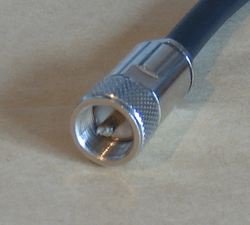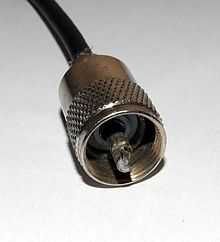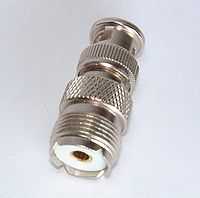UHF connector
 PL-259 (male) plug. Outside diameter is about 18 mm. | |||
| Type | RF coaxial connector | ||
|---|---|---|---|
| Production history | |||
| Designer | E. Clarke Quackenbush[1] | ||
| Designed | 1930s | ||
| Manufacturer | Various | ||
| General specifications | |||
| Diameter | 18 mm (0.71 in) (typical) | ||
| Cable | Coaxial | ||
| Passband | Typically 0-300 MHz | ||
| Connector | SO-239 (socket) PL-259 (plug) | ||


The UHF connector, also called the Amphenol coaxial connector,[2] is a World War II threaded RF connector design, from an era when "UHF" referred to frequencies over 30 MHz.[3] Originally intended for use as a video connector in radar applications, the connector was later used for other RF applications. This connector was developed on basis of a shielded banana plug.
UHF connectors are generally usable through what is now known as the VHF and HF frequencies[4] and can handle RF power levels over one kilowatt. There is variation between manufacturers with the choice of dielectric, the PTFE types being favored where low loss is desired. The average power handling of the PTFE versions is essentially set by heating of the center pin, and is therefore frequency-dependent, as the RF resistance rises as the skin depth falls. At low frequencies, the power handling is rather better than that of the similar-sized N connector. The UHF connector is the most common connector in amateur radio applications up to 150 MHz. In the US, the silver-plated version with Teflon dielectric is used in UHF applications up to 450 MHz for the 70 cm band.
Despite the name, the UHF connector is rarely used in commercial applications for UHF frequencies, as the non-constant impedance (the impedance drops to 30-40 Ω for about a centimeter in the central region of the connector) means they create significant electrical signal reflections above 300 MHz.[4][5][6]
The most popular cable plug and corresponding chassis-mount socket carry the old Signal Corps nomenclatures PL-259 (plug) and SO-239 (socket). The PL-259 can be used with large diameter coaxial cable, such as RG-8/U and RG-9/U, and the smaller diameter RG-58/U and RG-59/U with the use of UG-175/U and UG-176/U adapter sleeves. "PL-259" refers to one specific mechanical design, but the term is often used for any compatible UHF cable plug. The thread is 5⁄8 inch 24tpi UNEF standard. Other UHF connectors with a similar—but incompatible—metric thread have been produced. The center conductor jack on the SO-239 will also accept a 4 mm banana plug.
In many applications, UHF connectors were replaced by designs that have a more uniform impedance over the length of the connector, such as the N connector and the BNC connector,[7] but they are still widely used in amateur radio, citizens' band radio, and marine VHF radio where mechanical robustness and ease of use are more important than a small mismatch. The "classic" PL-259 connector is resistant to damage even if stepped on accidentally.
One reason for the popularity of the UHF connector is its ease of assembly. While crimp connectors exist, the solderable screw-on connector is more common because no expensive specialized crimping tools are required. The connector is not suitable for outdoor applications by itself, but can be made weather resistant by wrapping it with self-adhesive silicone C-Tape.
UHF connectors were also used for the input and output of composite video signals for older video equipment (such as VTRs and monitors) dating from the late 1970s and earlier. They were known by BBC engineers as "F & E" connectors, after Films & Equipment, a manufacturer.
See also
References
- ↑ http://www.amphenolrf.com/products/uhf.asp?N=0&sid=4D2A4C007867617F&
- ↑ Historical details on Amphenol site
- ↑ "Introduction to U.H.F.". The Radio Amateur's Handbook (18th ed.). West Hartford, CT: American Radio Relay League. 1941. pp. 362–363.
In Amateur work, the ultra-high-frequency region is considered to include the 56 to 60 Mc band and all higher frequency bands available for amateur use.
- ↑ 4.0 4.1 "‘UHF’ Connector Test Results". Connectors. Hamradio.me. October 2011. Retrieved 31 January 2012.
- ↑ "The UHF type connector under network analysis". Chris's Amateur Radio and Electronics resource pages. Retrieved 31 January 2012.
[. . .] at 432 MHz [. . .] we see a loss in the order of 1.0 dB, this equates to a transmission loss of around 6 Watts with 25 Watts input.
- ↑ Amphenol RF - UHF connector Series, retrieved 2010-08-05
- ↑ "Lab Tests: SMA, BNC, TNC and N Connectors". Connectors. Hamradio.me. August 2011. Retrieved 31 January 2012.